ANN-Based Real-Time Prediction of Heat and Mass Transfer in the Paper-Based Storage Enclosure for Sustainable Preventive Conservation
Abstract
:1. Introduction
- to develop a coupled heat and mass transfer model for predicting the micro-environment.
- to determine an acceptable macro-environment for obtaining the associated range of the relaxing control.
- to train an ANN model for real-time conformity monitoring of the micro-environment.
2. Methodology
2.1. Numerical Simulation of Heat and Mass Transfer
2.1.1. Model Setting
2.1.2. Model Validation
2.2. Determination of Acceptable Macro-Environment
2.2.1. Typical Reference Data Selection
2.2.2. Data Amplification
2.2.3. Determination Process of Acceptable Macro-Environment
2.3. ANN Modeling
2.3.1. Data Preparation
2.3.2. Architecture of the ANN
2.3.3. Evaluation of the Optimal LSTM Network
2.3.4. Practical Application of Real-Time Conformity Monitoring
Validation Experiment
Parallel Prediction
3. Results and Discussion
3.1. Comparison of Measured and Simulated Data in Heat and Mass Simulation
3.2. Acceptable Macro-Environment
3.3. Real-Time Prediction of Micro-Environment
4. Conclusions
Author Contributions
Funding
Data Availability Statement
Conflicts of Interest
Nomenclature
| ANN | Artificial Neural Network | RH | Relative Humidity |
| LSTM | Long Short-Term Memory | KGE | Kling-Gupta Efficiency |
| TR | Typical Reference | TMY | Typical Meteorological Year |
| FS | Finkelstein Schafer | FT | Fourier Transfer |
| MSE | Mean Square Error | RMSE | Root Mean Square Error |
| MAE | Mean Absolute Error | StD | standard deviation of the errors |
| effective volumetric heat capacity at constant pressure | moisture air density [kg/ m3] | ||
| heat capacity [J/(kg·K)] | moisture air velocity [m/s] | ||
| temperature [K] | effective thermal conductivity [W/(m·K)] | ||
| latent heat of evaporation [J/kg] | vapor permeability [s] | ||
| relative humidity | vapor mass fraction | ||
| vapor saturation pressure [Pa] | heat source [W/ m3·s] | ||
| moisture storage capacity [kg/ m3] | moisture diffusivity [m2/s] | ||
| moisture source [kg/m3·s] | fluid pressure [N/m2]. | ||
| viscous force [N/m2] | external forces applied to the fluid [N/m2]. | ||
| FT pairs in time domain | FT pairs in frequency domain | ||
| forget factor | sigmoid activation functions | ||
| hyperbolic tangent activation functions | recurrent information | ||
| input factor | cell state | ||
| output factor | bias | ||
| weights | , | input and output. |
References
- Muñoz-Viñas, S. Contemporary Theory of Conservation; Routledge: Oxfordshire, UK, 2012. [Google Scholar]
- Wang, Y.; Wang, Y.; Chen, Q.; Lei, Y.; Tang, K. Identification, deterioration, and protection of organic cultural heritages from a modern perspective. NPJ Herit. Sci. 2025, 13, 71. [Google Scholar] [CrossRef]
- Elnaggar, A.; Said, M.; Kraševec, I.; Said, A.; Grau-Bove, J.; Moubarak, H. Risk analysis for preventive conservation of heritage collections in Mediterranean museums: Case study of the museum of fine arts in Alexandria (Egypt). Herit. Sci. 2024, 12, 1–17. [Google Scholar] [CrossRef]
- Ganguly, S.; Wang, F.; Browne, M. Comparative methods to assess renovation impact on indoor hygrothermal quality in a historical art gallery. Indoor Built Environ. 2019, 28, 492–505. [Google Scholar] [CrossRef]
- Wang, F.; Ganguly, S. Effects of Renovation Solutions in a Historical Building of Cultural Significance; Papyrus Publishing: Merseyside, UK, 2015. [Google Scholar]
- Fernandez-Cortes, A.; Palacio-Perez, E.; Martin-Pozas, T.; Cuezva, S.; Ontañon, R.; Lario, J.; Sanchez-Moral, S. Defining the Optimal Ranges of Tourist Visits in UNESCO World Heritage Caves with Rock Art: The Case of El Castillo and Covalanas (Cantabria, Spain). Appl. Sci. 2025, 15, 3484. [Google Scholar] [CrossRef]
- Harrestrup, M.; Svendsen, S. Internal insulation applied in heritage multi-storey buildings with wooden beams embedded in solid masonry brick façades. Build. Environ. 2016, 99, 59–72. [Google Scholar] [CrossRef]
- Shiner, J. Trends in microclimate control of museum display cases. Mus. Microclim. 2007, 267–275. [Google Scholar]
- Cao, S.; Ge, W.; Yang, Y.; Huang, Q.; Wang, X. High strength, flexible, and conductive graphene/polypropylene fiber paper fabricated via papermaking process. Adv. Compos. Hybrid Mater. 2022, 5, 104–112. [Google Scholar] [CrossRef]
- Zhao, C.; Mark, L.H.; Chang, E.; Chu, R.K.; Lee, P.C.; Park, C.B. Highly expanded, highly insulating polypropylene/polybutylene-terephthalate composite foams manufactured by nano-fibrillation technology. Mater. Des. 2020, 188, 108450. [Google Scholar] [CrossRef]
- Jose, J.; Thomas, V.; Raj, A.; John, J.; Mathew, R.M.; Vinod, V.; Mujeeb, A. Eco-friendly thermal insulation material from cellulose nanofibre. J. Appl. Polym. Sci. 2020, 137, 48272. [Google Scholar] [CrossRef]
- Gane, P.A.; Ridgway, C.J. Moisture pickup in calcium carbonate coating structures: Role of surface and pore structure geometry. Nord. Pulp Pap. Res. J. 2009, 24, 298–308. [Google Scholar] [CrossRef]
- Derluyn, H.; Janssen, H.; Diepens, J.; Derome, D.; Carmeliet, J. Hygroscopic Behavior of Paper and Books. J. Build. Phys. 2007, 31, 9–34. [Google Scholar] [CrossRef]
- Han, B.; Li, X.; Wang, F.; Bon, J.; Symonds, I. The buffering effect of a paper-based storage enclosure made from functional materials for preventive conservation. Indoor Built Environ. 2024, 33, 167–182. [Google Scholar] [CrossRef]
- Perino, M. Air tightness and RH control in museum showcases: Concepts and testing procedures. J. Cult. Herit. 2018, 34, 277–290. [Google Scholar] [CrossRef]
- van Schijndel, A.W.M. Integrated Heat Air and Moisture Modeling and Simulation. Ph.D. Thesis, Technische Universiteit Eindhoven, Eindhoven, The Netherlands, 2007. [Google Scholar]
- Simonson, C.J.; Salaonvaara, M.; Ojanen, T. Heat and Mass Transfer between Indoor Air and a Permeable and Hygroscopic Building Envelope: Part II—Verification and Numerical Studies. J. Therm. Envel. Build. Sci. 2004, 28, 161–185. [Google Scholar] [CrossRef]
- Dong, W.; Chen, Y.; Bao, Y.; Fang, A. A validation of dynamic hygrothermal model with coupled heat and moisture transfer in porous building materials and envelopes. J. Build. Eng. 2020, 32, 101484. [Google Scholar] [CrossRef]
- Singh, S.; Abbassi, H. 1D/3D transient HVAC thermal modeling of an off-highway machinery cabin using CFD-ANN hybrid method. Appl. Therm. Eng. 2018, 135, 406–417. [Google Scholar] [CrossRef]
- Darvishvand, L.; Safari, V.; Kamkari, B.; Alamshenas, M.; Afrand, M. Machine learning-based prediction of transient latent heat thermal storage in finned enclosures using group method of data handling approach: A numerical simulation. Eng. Anal. Bound. Elements 2022, 143, 61–77. [Google Scholar] [CrossRef]
- Ganguly, S.; Ahmed, A.; Wang, F. Optimised building energy and indoor microclimatic predictions using knowledge-based system identification in a historical art gallery. Neural Comput. Appl. 2020, 32, 3349–3366. [Google Scholar] [CrossRef]
- Steeman, H.-J.; Van Belleghem, M.; Janssens, A.; De Paepe, M. Coupled simulation of heat and moisture transport in air and porous materials for the assessment of moisture related damage. Build. Environ. 2009, 44, 2176–2184. [Google Scholar] [CrossRef]
- CEN EN 15026-2007; Hygrothermal Performance of Building Components and Building Elements–Assessment of Moisture Transfer by Numerical Simulation. CEN: Brussels, Belgium, 2007.
- Tariku, F.; Kumaran, K.; Fazio, P. Transient model for coupled heat, air and moisture transfer through multilayered porous media. Int. J. Heat Mass Transf. 2010, 53, 3035–3044. [Google Scholar] [CrossRef]
- Li, L.; Zhang, C.; Xu, X.; Yu, J.; Wang, F.; Gang, W.; Wang, J. Simulation study of a dual-cavity window with gravity-driven cooling mechanism. In Building Simulation; Tsinghua University Press: Beijing, China, 2022; pp. 1–14. [Google Scholar]
- Liu, D. A rational performance criterion for hydrological model. J. Hydrol. 2020, 590, 125488. [Google Scholar] [CrossRef]
- Knoben, W.J.; Freer, J.E.; Woods, R.A. Inherent benchmark or not? Comparing Nash–Sutcliffe and Kling–Gupta efficiency scores. Hydrol. Earth Syst. Sci. 2019, 23, 4323–4331. [Google Scholar] [CrossRef]
- Lee, K.; Yoo, H.; Levermore, G.J. Generation of typical weather data using the ISO Test Reference Year (TRY) method for major cities of South Korea. Build. Environ. 2010, 45, 956–963. [Google Scholar] [CrossRef]
- ISO 15927–4; Hourly Data for Assessing the Annual Energy Use for Heating and Cooling. International Organization for Standardization: Geneva, Switzerland, 2005.
- Grass, A.M.; Gibbs, F.A. A Fourier transform of the electroencephalogram. J. Neurophysiol. 1938, 1, 521–526. [Google Scholar] [CrossRef]
- Sanei, S.; Chambers, J.A. EEG Signal Processing; John Wiley & Sons: Hoboken, NY, USA, 2013. [Google Scholar]
- Sawant, H.K.; Jalali, Z. Detection and classification of EEG waves. Orient. J. Comput. Sci. Technol. 2010, 3, 207–213. [Google Scholar]
- Nussbaumer, H.J.; Nussbaumer, H.J. The Fast Fourier Transform; Springer: Berlin/Heidelberg, Germany, 1982; pp. 80–111. [Google Scholar]
- British Standards Institution. Specification for Managing Environmental Conditions for Cultural Collections: PAS 198: 2012; British Standards Limited: London, UK, 2012. [Google Scholar]
- Qiao, D.; Li, P.; Ma, G.; Qi, X.; Yan, J.; Ning, D.; Li, B. Realtime prediction of dynamic mooring lines responses with LSTM neural network model. Ocean Eng. 2021, 219, 108368. [Google Scholar] [CrossRef]
- Granata, F.; Di Nunno, F.; de Marinis, G. Stacked machine learning algorithms and bidirectional long short-term memory networks for multi-step ahead streamflow forecasting: A comparative study. J. Hydrol. 2022, 613, 128431. [Google Scholar] [CrossRef]
- Arslan, N.; Sekertekin, A. Application of Long Short-Term Memory neural network model for the reconstruction of MODIS Land Surface Temperature images. J. Atmos. Sol.-Terr. Phys. 2019, 194, 105100. [Google Scholar] [CrossRef]
- Hochreiter, S.; Schmidhuber, J. Long short-term memory. Neural Comput. 1997, 9, 1735–1780. [Google Scholar] [CrossRef]
- Yu, Y.; Si, X.; Hu, C.; Zhang, J. A Review of Recurrent Neural Networks: LSTM Cells and Network Architectures. Neural Comput. 2019, 31, 1235–1270. [Google Scholar] [CrossRef]
- Gal, Y.; Ghahramani, Z. A theoretically grounded application of dropout in recurrent neural networks. Adv. Neural Inf. Process. Syst. 2016, 29, 4–8. [Google Scholar]
- Srivastava, N.; Hinton, G.; Krizhevsky, A.; Sutskever, I.; Salakhutdinov, R. Dropout: A simple way to prevent neural networks from overfitting. J. Mach. Learn. Res. 2014, 15, 1929–1958. [Google Scholar]
- Ma, W.; Lu, J. An Equivalence of Fully Connected Layer and Convolutional Layer. arXiv 2017, arXiv:1712.01252. [Google Scholar]
- Muppidi, S.; Om Prakash, P.G. Dragonfly Political Optimizer Algorithm-Based Rider Deep Long Short-Term Memory for Soil Moisture and Heat Level Prediction in IoT. Comput. J. 2022, 66, 1350–1365. [Google Scholar] [CrossRef]
- Song, W.; Gao, C.; Zhao, Y.; Zhao, Y. A time series data filling method based on LSTM—Taking the stem moisture as an example. Sensors 2020, 20, 5045. [Google Scholar] [CrossRef]
- Jabbar, H.K.; Khan, R.Z. Methods to Avoid Over-Fitting and Under-Fitting in Supervised Machine Learning (Comparative Study). Comput. Sci. Commun. Instrum. Devices 2015, 70, 163–172. [Google Scholar]
- Bilbao, I.; Bilbao, J. Overfitting problem and the over-training in the era of data: Particularly for Artificial Neural Networks. In Proceedings of the 2017 Eighth International Conference on Intelligent Computing and Information Systems (ICICIS), Cairo, Egypt, 5–7 December 2017; pp. 173–177. [Google Scholar]
- Althelaya, K.A.; El-Alfy, E.S.M.; Mohammed, S. Evaluation of bidirectional LSTM for short-and long-term stock market prediction. In Proceedings of the 2018 9th International Conference on Information and Communication Systems (ICICS), Irbid, Jordan, 3–5 April 2018; pp. 151–156. [Google Scholar]
- Perles, A.; Fuster-López, L.; Bosco, E. Preventive conservation, predictive analysis and environmental monitoring. Herit. Sci. 2024, 12, 11. [Google Scholar] [CrossRef]
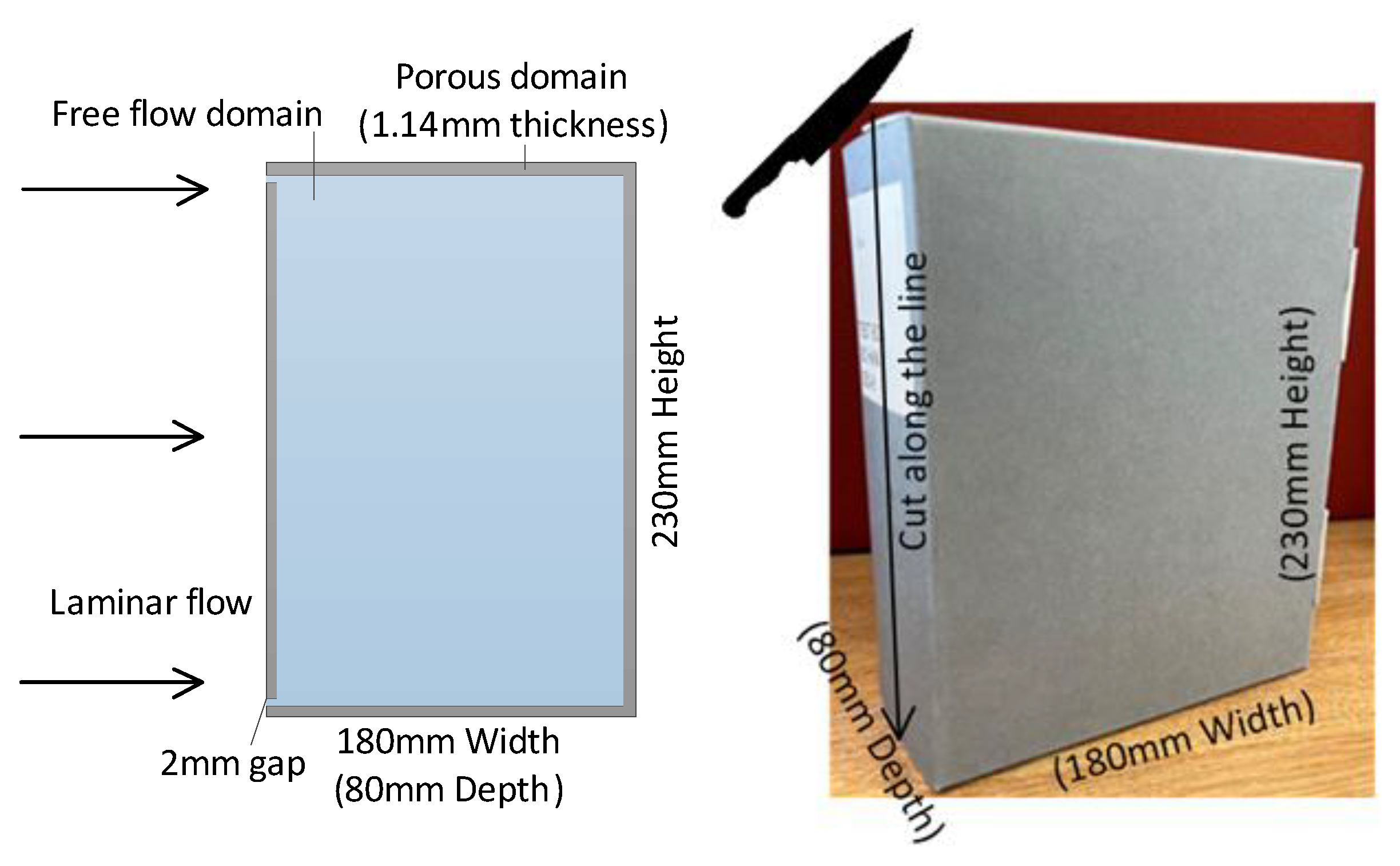




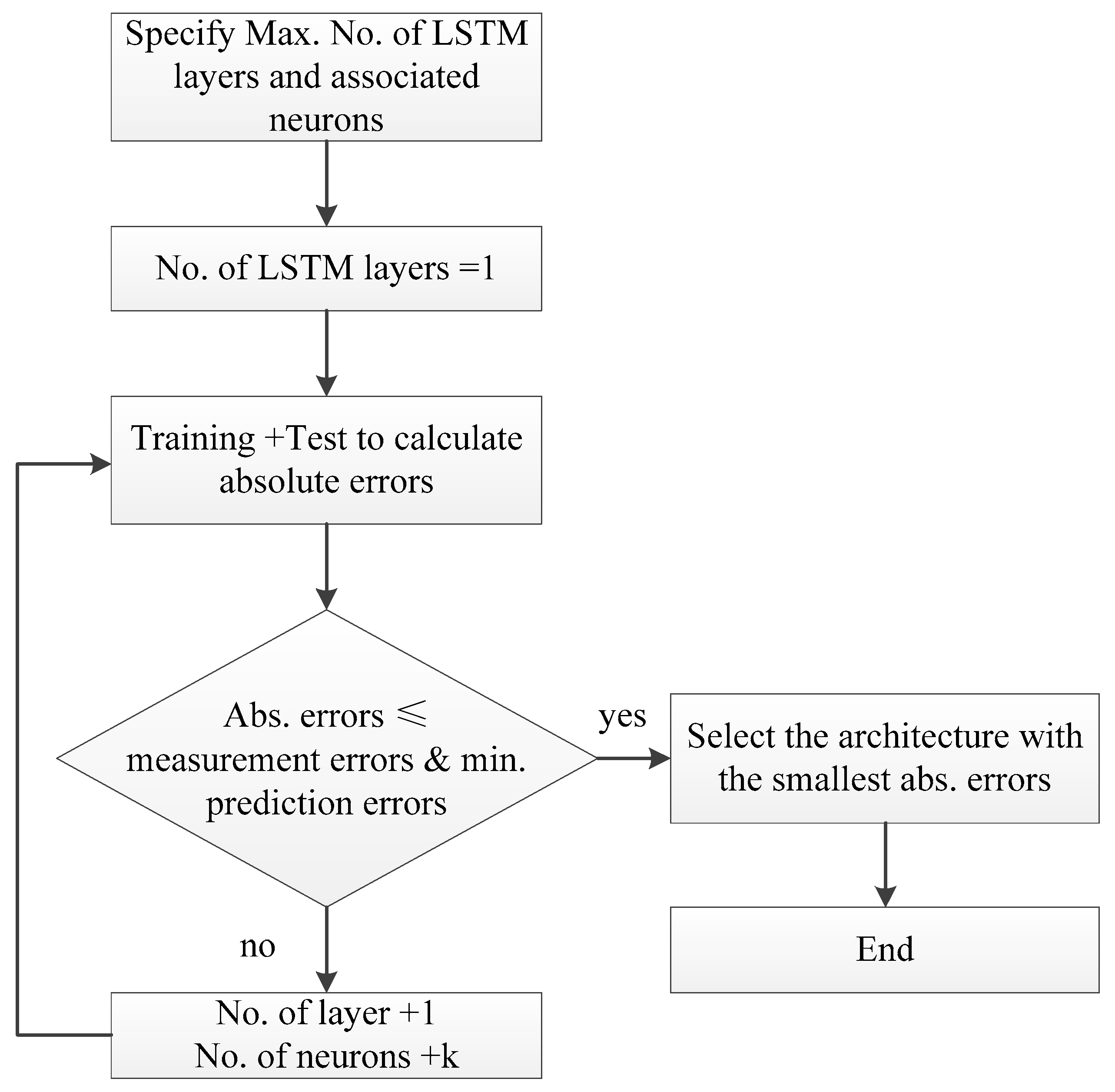


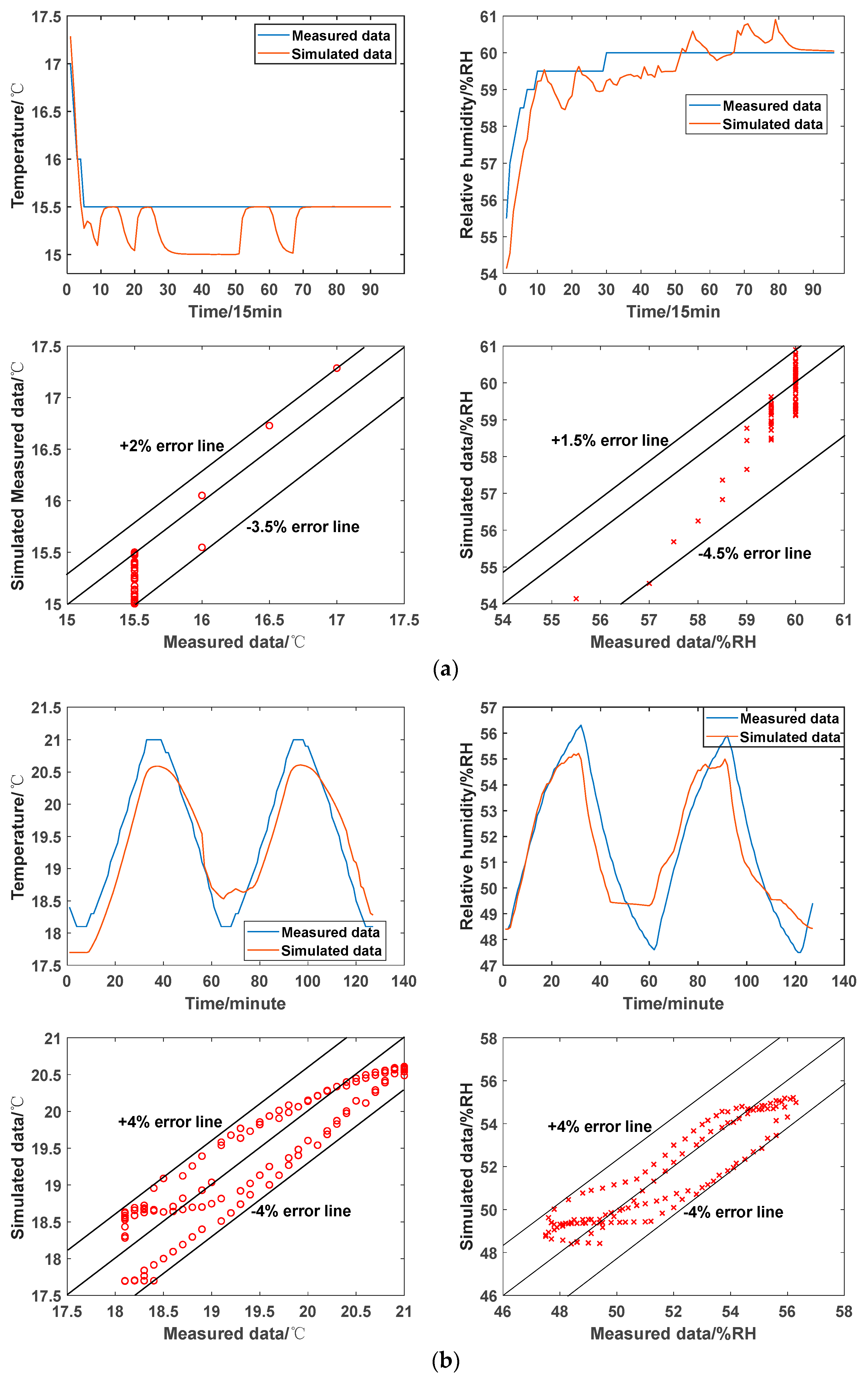
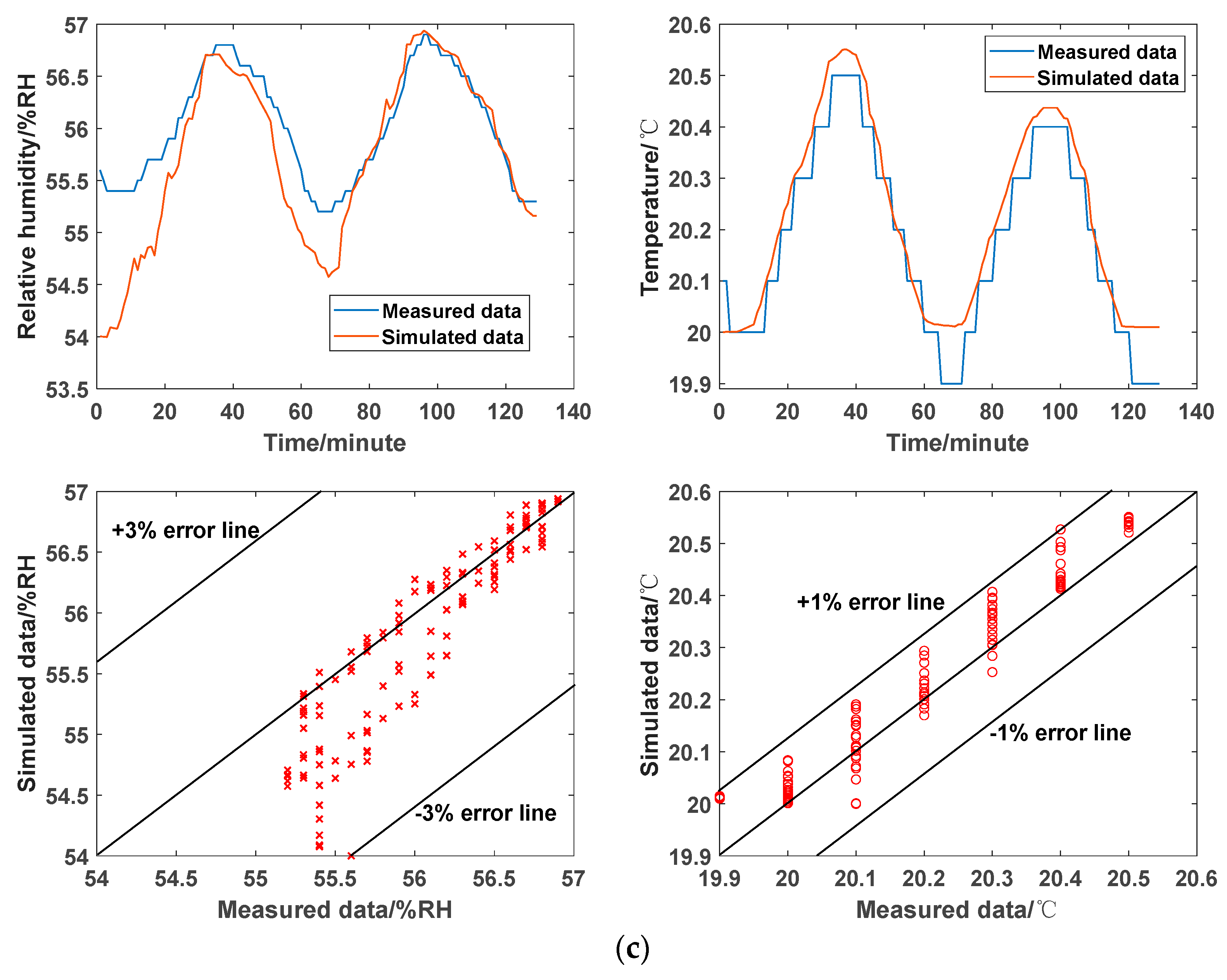

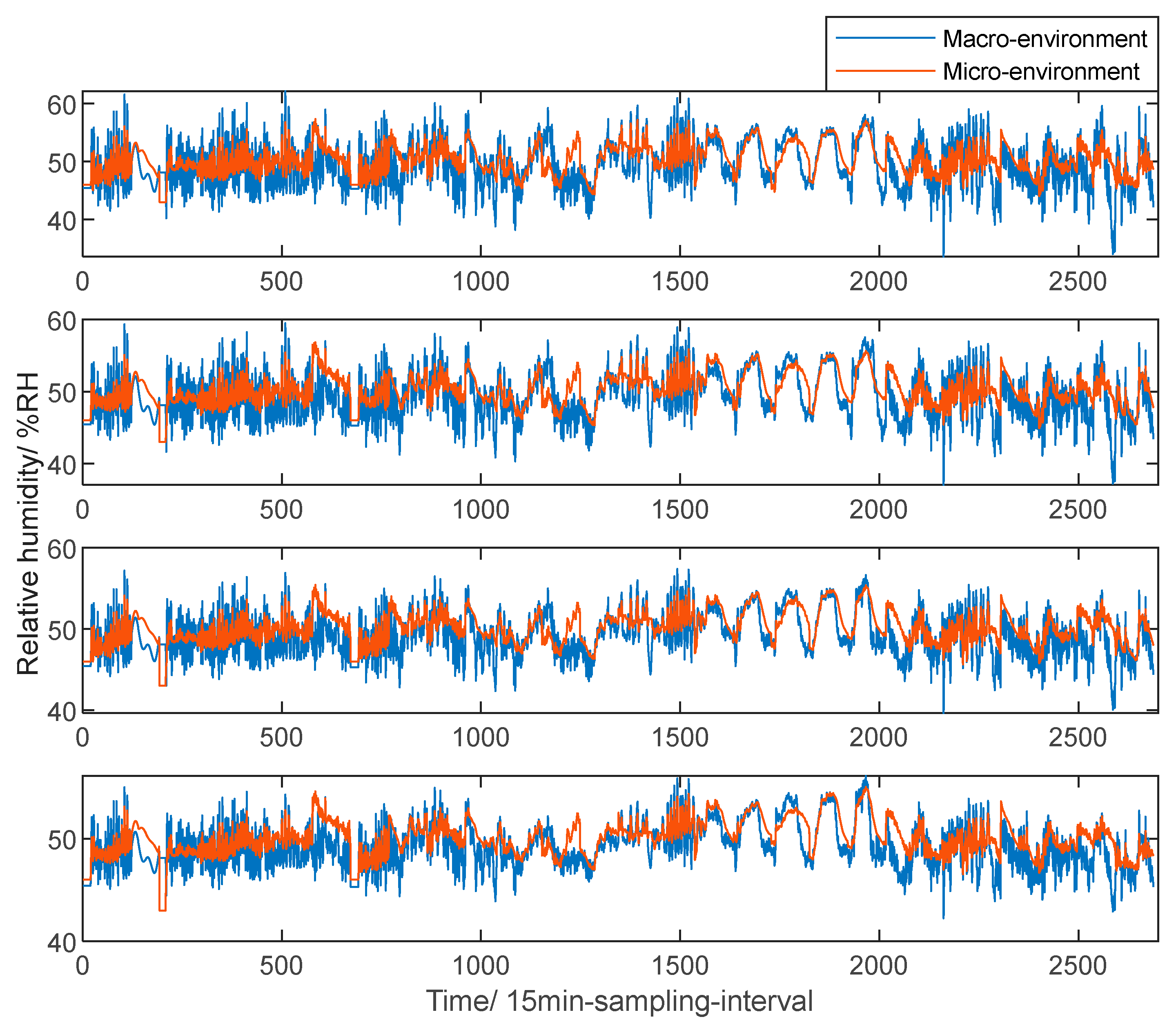
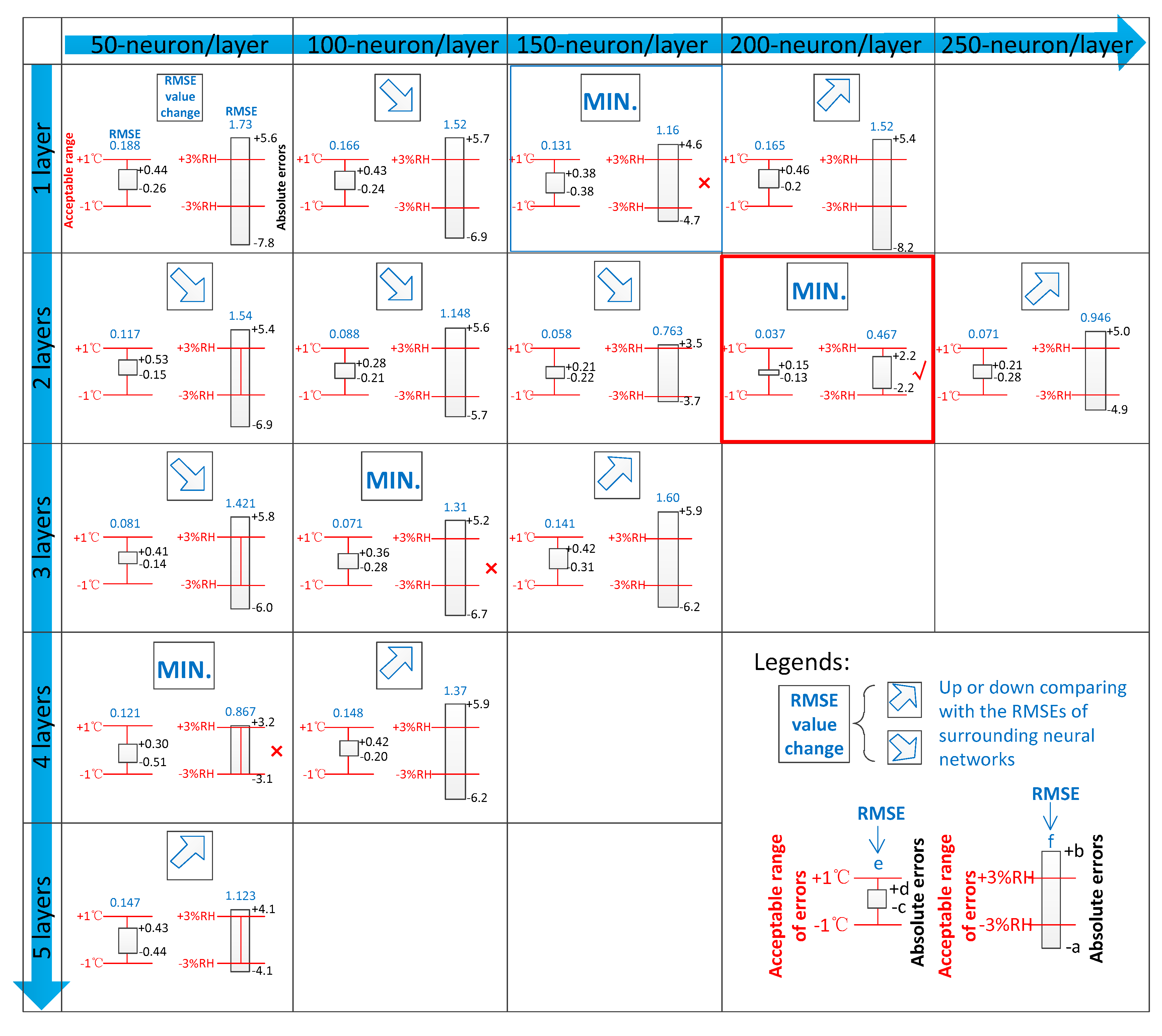

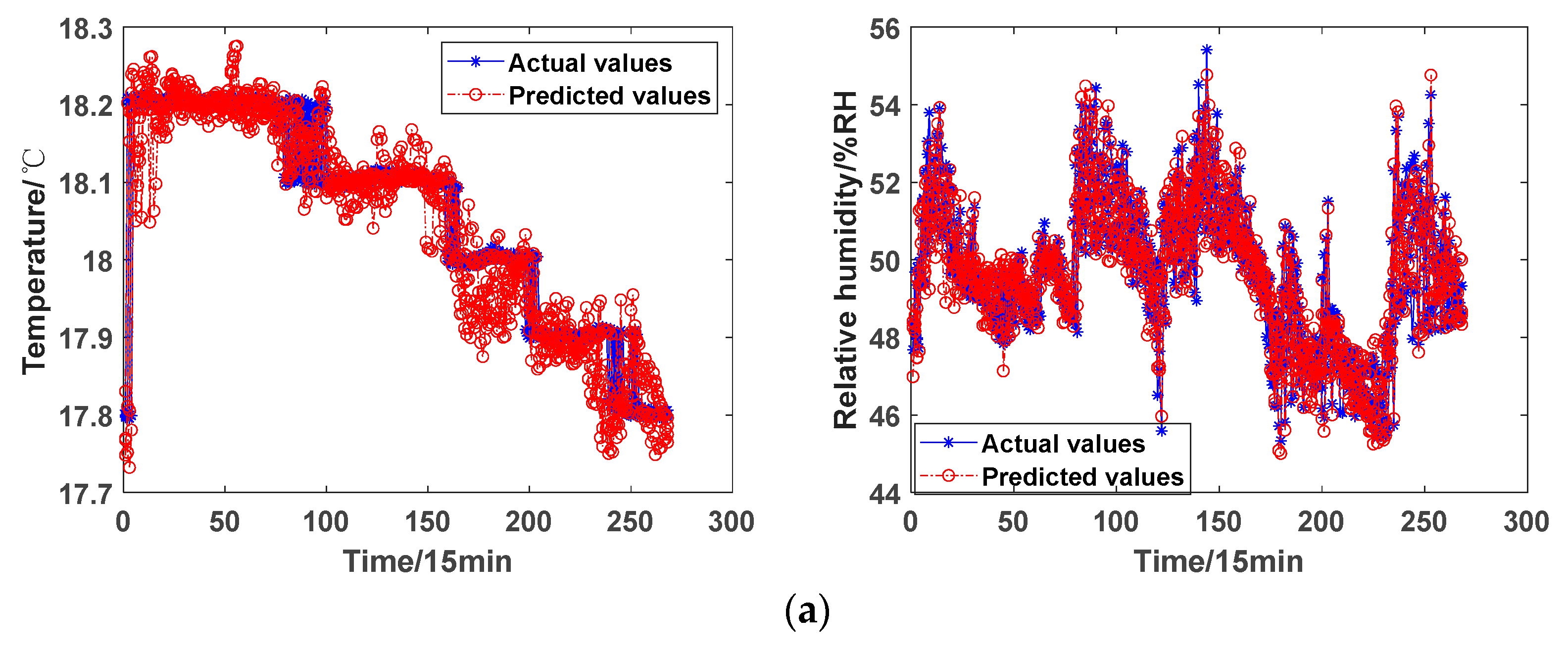
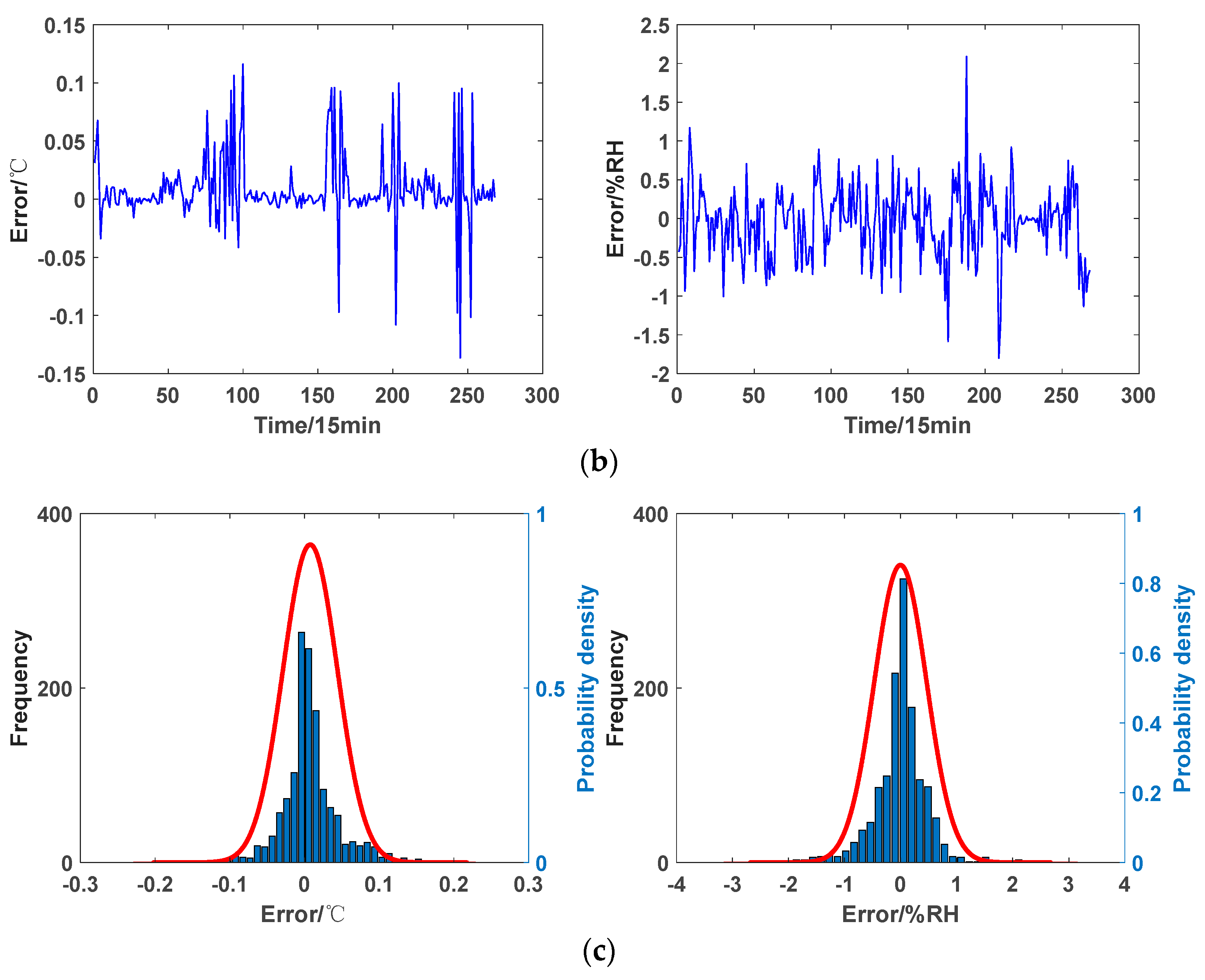
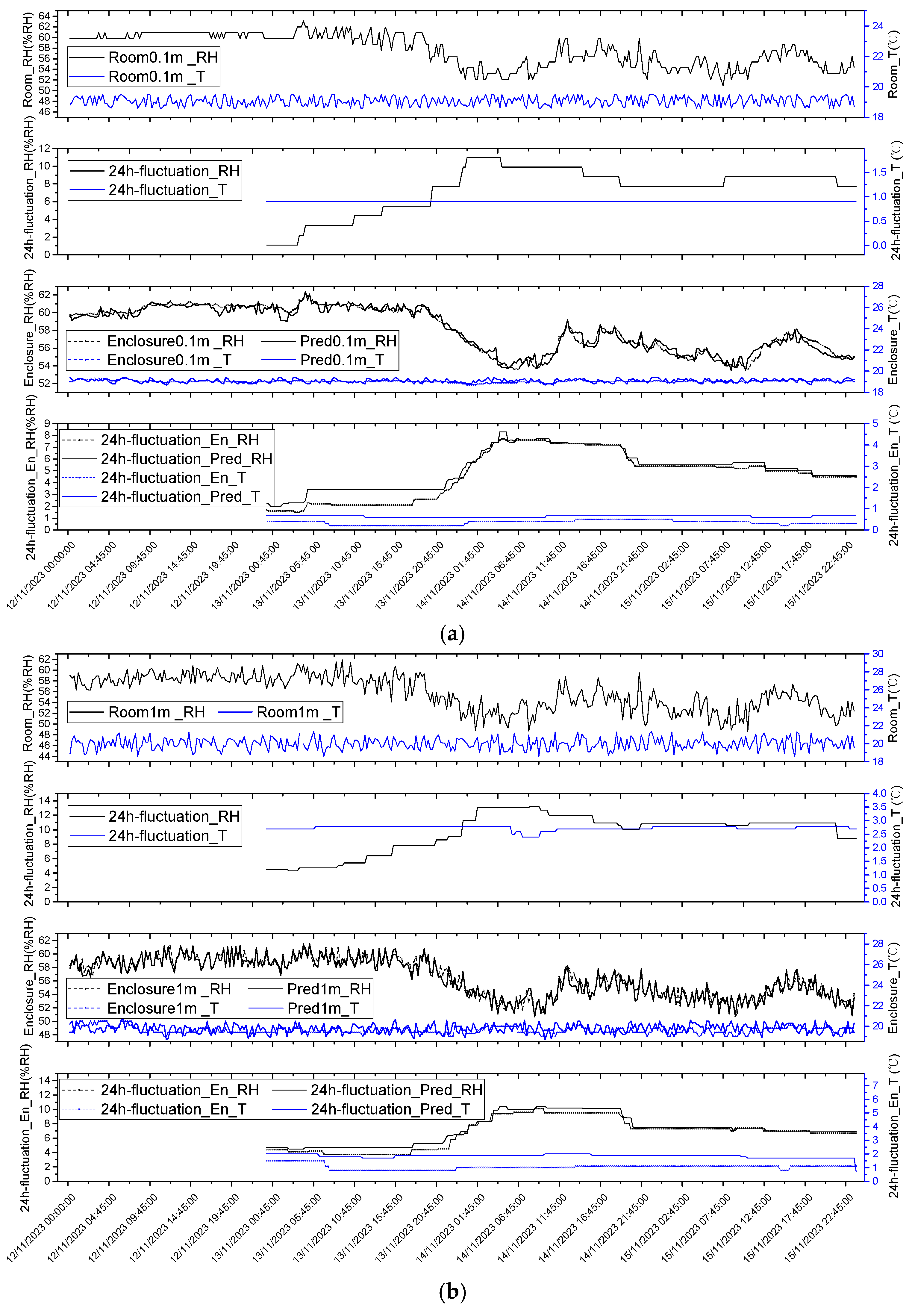
| Description | Value | Unit |
|---|---|---|
| ① Carboard material | ||
| Density | 662 | kg/m3 |
| Thermal conductivity | 0.055 | W/(m·K) |
| Heat capacity at constant pressure | 1.028 | J/(kg·K) |
| Diffusion coefficient | 1.49 × 10−10 | m2/s |
| Water content | kg/m3 | |
| Vapor resistance factor | 95.63 | - |
| ② Boundary condition | ||
| Laminar air flow | 0.2 | m/s |
| Temperature | macro-environmental temperature | °C |
| RH | macro-environmental RH | %RH |
| Upper and lower gaps of the enclosure | open boundary | - |
| Initial conditions | ||
| Temperature and RH in both domains | macro-environmental temperature and RH at the first second | °C and %RH |
| Velocity in both domains | 0.2 | m/s |
| Pressure in both domains | (ambient pressure—reference pressure) | Pa |
| ③ Meshing | ||
| Element types | triangular or quadrilateral | - |
| No. of layers in porous media | 2~4 | - |
| Mesh density | dense in the porous domain and gradually course toward the center of free flow domain | - |
| Maximum element growth rate | 1.05 | - |
| Maximum curvature factor | 0.2 | - |
| ④ Solver | ||
| Time stepping | second-order BDF | - |
| Maximum step | 0.25 | h |
| Solving method | automatic Newton | - |
| tolerance factor | 0.01 | - |
| maximum No. of iterations | 4 | - |
| Level | 24 h Fluctuation (Band) in Macro-Environment | 24 h Fluctuation (Band) in Micro-Environment | Amplification Factor |
|---|---|---|---|
| 1 | ±10 (42.2~56.1) %RH | ±7.1 (45.5~55) %RH | 10 |
| 2 | ±12 (39.6~57.4) %RH | ±7.9 (44.7~55.4) %RH | 11.6 |
| 3 | ±14 (37~59.4) %RH | ±8.1 (43.8~56.8) %RH | 13.4 |
| 4 | ±16 (33~65) %RH | ±9.1 (43~57.3) %RH | 15 |
| Tigh-Control | ↑↓5 °C @50 %RH | ↑↓10 %RH @20 °C | |
|---|---|---|---|
| KGE for temp. | 0.51 | 0.84 | 0.97 |
| KGE for RH | 0.58 | 0.77 | 0.63 |
| R2 | RMSE | MSE | MAE | StD | |
|---|---|---|---|---|---|
| Training data (temperature) | 0.999 | 0.035 | 0.001 | 0.023 | 0.035 |
| Training data (RH) | 0.984 | 0.364 | 0.132 | 0.230 | 0.364 |
| Testing data (temperature) | 0.965 | 0.037 | 0.001 | 0.025 | 0.037 |
| Testing data (RH) | 0.963 | 0.468 | 0.219 | 0.313 | 0.468 |
Disclaimer/Publisher’s Note: The statements, opinions and data contained in all publications are solely those of the individual author(s) and contributor(s) and not of MDPI and/or the editor(s). MDPI and/or the editor(s) disclaim responsibility for any injury to people or property resulting from any ideas, methods, instructions or products referred to in the content. |
© 2025 by the authors. Licensee MDPI, Basel, Switzerland. This article is an open access article distributed under the terms and conditions of the Creative Commons Attribution (CC BY) license (https://creativecommons.org/licenses/by/4.0/).
Share and Cite
Han, B.; Wang, F.; Bon, J.; MacMillan, L.; Taylor, N.K. ANN-Based Real-Time Prediction of Heat and Mass Transfer in the Paper-Based Storage Enclosure for Sustainable Preventive Conservation. Appl. Sci. 2025, 15, 6905. https://doi.org/10.3390/app15126905
Han B, Wang F, Bon J, MacMillan L, Taylor NK. ANN-Based Real-Time Prediction of Heat and Mass Transfer in the Paper-Based Storage Enclosure for Sustainable Preventive Conservation. Applied Sciences. 2025; 15(12):6905. https://doi.org/10.3390/app15126905
Chicago/Turabian StyleHan, Bo, Fan Wang, Julie Bon, Linda MacMillan, and Nick K. Taylor. 2025. "ANN-Based Real-Time Prediction of Heat and Mass Transfer in the Paper-Based Storage Enclosure for Sustainable Preventive Conservation" Applied Sciences 15, no. 12: 6905. https://doi.org/10.3390/app15126905
APA StyleHan, B., Wang, F., Bon, J., MacMillan, L., & Taylor, N. K. (2025). ANN-Based Real-Time Prediction of Heat and Mass Transfer in the Paper-Based Storage Enclosure for Sustainable Preventive Conservation. Applied Sciences, 15(12), 6905. https://doi.org/10.3390/app15126905







